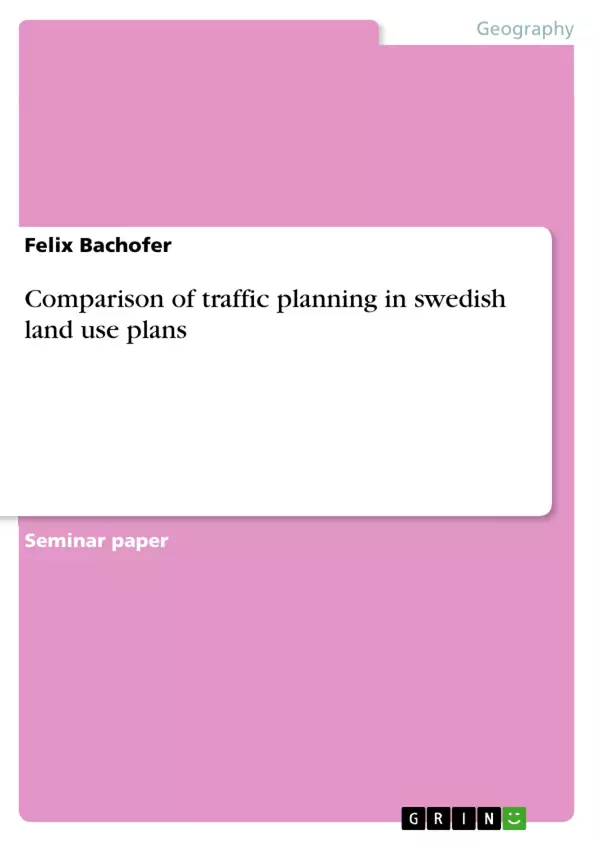This essay compares different preparatory land-use plans from Uppsala län and Stockholm län in Sweden concerning topics of their traffic planning. The reason for the selection of plans from these two regions is firstly the limited possibility to compare bigger numbers of plans in this short essay and secondly the spatial nearness of them.
But what is the reason to compare the traffic planning anyway? The population development, the load of the road net, the changing usage of vehicles of all kind, the traffic safety, rising energy prices, economical and environmental questions and the purpose of municipalities and the state to offer their citizens a proper possibility of mobility are only a few reasons to perform a balanced, long-sighted and sustainable planning. The main emphasis of this essay is to check if different municipalities aspire after solutions for a decreasing car use, environmental friendly concepts and how they want to regulate their objectives. Of course is such a comparison not very easy to perform, because of the different size and preconditions of the municipalities and the age of their preparatory land-use plan. The essay will at first introduce into the problem, different planning tools and the preconditions in the region, and then it will continue with a short summary of the traffic planning in each chosen land-use plan and will after that compare some main issues within the plans followed by conclusion of the results.
Inhaltsverzeichnis (Table of Contents)
- Introduction
- What are the functions of “preparatory land-use plans”?
- Overview
- Presentation of problems
- Framework of strategies
- Expected development of population and usage of vehicles
- Aims of Stockholm läns regional planning
- Aims of Uppsala läns regional planning
- Traffic planning in different preparatory land-use plans
- Tabular comparison of the plans
- Result of comparison
Zielsetzung und Themenschwerpunkte (Objectives and Key Themes)
This essay compares different preparatory land-use plans from Uppsala län and Stockholm län in Sweden, specifically focusing on their traffic planning strategies. The primary objective is to investigate whether municipalities strive for solutions that promote a reduction in car usage and the implementation of environmentally friendly concepts, and how they aim to regulate their objectives. The analysis takes into account the varied sizes, preconditions, and ages of the municipalities and their preparatory land-use plans.
- Comparison of traffic planning strategies in different Swedish municipalities
- Emphasis on environmentally friendly concepts and reduction in car use
- Analysis of the objectives and regulations of municipalities regarding traffic planning
- Exploration of the impact of population growth and vehicle usage on traffic planning
- Assessment of the effectiveness of different strategies for managing traffic and environmental concerns
Zusammenfassung der Kapitel (Chapter Summaries)
- Introduction: The introduction provides a background for the essay, outlining its focus on comparing traffic planning in Swedish preparatory land-use plans. It emphasizes the importance of balanced, long-sighted, and sustainable planning due to factors such as population growth, road network strain, and environmental concerns. The essay aims to investigate the municipalities' aspirations towards reducing car dependency and promoting environmentally friendly concepts.
- What are the functions of “preparatory land-use plans”?: This chapter defines the concept of "preparatory land-use plans" in Sweden, outlining their legal framework, purpose, and binding nature. It emphasizes the importance of addressing general public interests, environmental and risk factors, and areas of national interest in these plans. The chapter also highlights the connection between preparatory land-use plans and "binding land-use plans".
- Overview: This chapter presents an overview of the problems associated with road traffic, including its impact on health, environment, and the quality of life. It then outlines three main strategies for transport policy to reduce traffic impacts: technical improvements, traffic avoidance, and traffic deflection. The chapter also discusses the expected development of population and vehicle usage in the Stockholm and Uppsala regions, highlighting the growing need for sustainable transportation solutions.
- Aims of Stockholm läns regional planning: This chapter focuses on the objectives outlined in the Regional Development Plan 2001 for the Stockholm Region. It highlights the emphasis on improving regional accessibility, reducing traffic congestion, enhancing traffic safety, and implementing environmentally friendly measures such as noise protection and support for public transportation.
- Aims of Uppsala läns regional planning: This chapter explores the aims of Uppsala län's regional planning, emphasizing its focus on reducing traffic's negative impact on climate and fresh air. It highlights the objectives of shifting goods transport from roads to rails, promoting active and attractive public transportation, and adjusting the traffic system to environmental considerations.
Schlüsselwörter (Keywords)
Key terms and concepts that dominate this essay include preparatory land-use plans, traffic planning, environmental sustainability, car use reduction, environmentally friendly concepts, population growth, vehicle usage, regional accessibility, traffic congestion, traffic safety, public transportation, and sustainable transportation solutions. These terms reflect the essay's focus on analyzing the strategies and objectives of Swedish municipalities in addressing the complex challenges posed by traffic and its impact on the environment, social well-being, and the economy.
- Citar trabajo
- Felix Bachofer (Autor), 2006, Comparison of traffic planning in swedish land use plans, Múnich, GRIN Verlag, https://www.grin.com/document/53772



